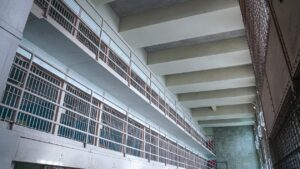
A prison’s purpose is to house perpetrators of crimes. The most essential role of any prison is to ensure that people can not escape. To achieve this goal, they are usually surrounded by various barriers such as large fences topped with several rows of barbed wire, tall brick walls and several guard towers in which armed officers keep watch for escape attempts or other problems. The guards who work inside of these locations are often sharp shooters with several different weapons at their immediate disposal. A prison is designed to look imposing and threatening, with no way of escape.
To get beyond the boundaries of these security measures, prisoners are taken into the facility through the main gate. This leads inside the actual penitentiary where inmates are checked in and assigned to a particular cell number. A large portion of a prisoner’s time is spent inside of their cell, which is the small room they are housed in for the duration of their sentence. These rooms are very sparse, usually consisting of a bunk bed, toilet and little open space to move around. Cells are lined up side by side on a prison block where the general population of prisoners’ lives. Most prisons have a smaller block of cells that are completely closed off to create isolation units: this is an area for prisoners who appear to be suicidal and are under non-stop observation. Some prisons also include a separate area for inmates who have been condemned to death.
When not in their cells, prisoners spend their time in a variety of other areas. Prisoners are taken to an exercise yard where they can participate in recreational activities and get fresh air. This is normally a large open space that is heavily patrolled by armed guards. Religious services are held once a week or more inside of a prison chapel, but attendance is optional. When an inmate has a visitor, they are escorted to a separate visitation area. Contact with guests is limited, and highly regulated. Most prisons also have a library and even an area where they can take educational courses. One of the most important rooms inside of every prison is the cafeteria, where inmates eat all of their meals in a large group.
Some prisons are geared toward giving prisoners jobs to complete while they are locked up. This can include anything from cleaning food trays in the kitchen to washing clothes in a laundry room. A few facilities have specific areas built in where inmates can spend their days working in an industrial setting, and they may even earn a small salary in exchange.
Prisons are designed to be well monitored, so most facilities include a vast network of cameras and closed captioned televisions that are watched by armed guards. This allows every section of a penitentiary to be constantly and actively monitored. One modern trend in prison facilities is to decrease the free space prisoners spend their time in while out of their cells. The goal is to better maintain control over the prisoners and create a more secure environment.
